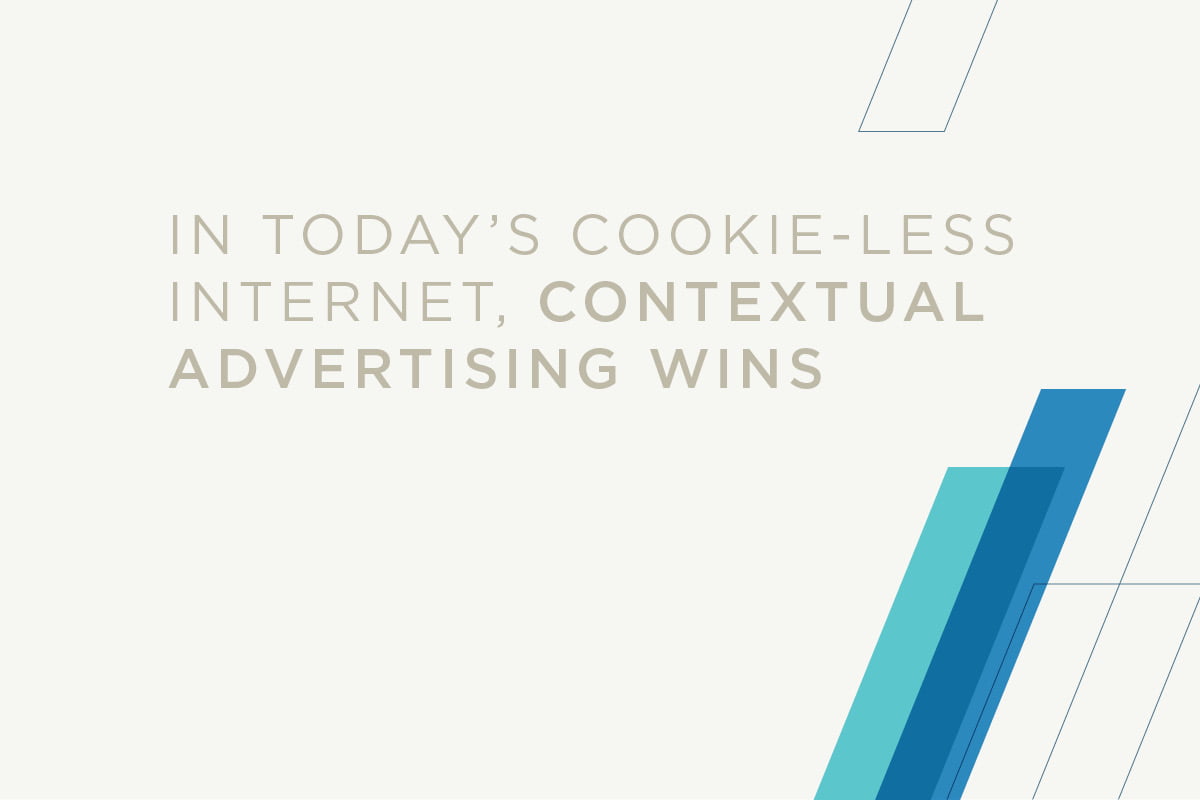Summary
- As the end of third-party cookies draws near, marketers are looking for new ways to reach and engage key audiences.
- While not new, contextual advertising is a great solution to serve consumers with relevant, targeted ads in a cookie-less world.
As Apple®, Google® and Mozilla® phase out browser support for third-party cookies, many advertisers are challenged to track users online and serve targeted ads. But digital advertising is not solely dependent on behavioral targeting. Contextual advertising is a viable alternative that is making a comeback, offering brands more advanced targeting capabilities.
Contextual advertising targets users based on the content of the webpage they are currently viewing. By delivering ads that match the user’s current interests, contextual advertising can increase the likelihood of the user clicking on the ad and making a purchase.
Concerns over privacy
With behavioral targeting through cookies already waning, contextual advertising has started to become an attractive option for marketers. It has become more relevant than ever as it fills the gap left by third-party data.
Cookies track users across multiple sites, which can raise privacy concerns. As such, stricter privacy regulations and data-protection laws have been implemented worldwide.
This makes contextual advertising a more privacy-friendly option since it does not use or collect cookies to track individual users. Instead, it analyzes the content of a web page to serve ads, so marketers can serve personalized, relevant ads to consumers without implicating privacy concerns.
Not the contextual advertising you used to know
While the practice of delivering contextual ads started two decades ago, it has evolved to become a more sophisticated targeting method. Due to technological advances, contextual advertising today is more automated, advanced and far-reaching. These are some of the changes that characterize today’s contextual ads:
- Multichannel advertising: Previously contextual advertising primarily focused on display advertising on websites. It can now be used across multiple channels, including search engines, social media and Connected TV. Contextual advertising can fit into omnichannel campaigns by providing customers a consistent, cohesive and seamless advertising experience, regardless of the channel they use to interact with a brand.
- Programmatic bidding: Previously, advertisers had to work with lots of different publishers individually. Now, they can choose specific topics or areas where they want their ads to show up and work across thousands of publishers all at once, without having to deal with them individually.
- Artificial intelligence: With the rise of artificial intelligence and machine learning, contextual advertising has become more sophisticated in analyzing and interpreting the content of web pages, social media posts and search queries. This helps advertisers to deliver more targeted and relevant ads to users.
- Mobile optimization: As more consumers use mobile devices, contextual advertising has become better optimized for mobile. Advertisers can now deliver ads specifically designed for mobile devices, considering factors like screen size and user behavior.
Considerations in contextual advertising
Serving contextual ads is not as simple as matching ads with keywords and content. You should consider these factors to avoid damage to your brand reputation:
- Brand safety: Ensure your ads are placed in appropriate and safe environments. This means avoiding content that is violent, offensive, insensitive or controversial. Use negative keywords so that your ads do not appear beside such content and on websites that you do not want your brand to be associated with.
- Speed: With the rise of RTB and programmatic advertising, speed is critical in contextual advertising. You should ensure your ads are delivered quickly and efficiently and that the content your ads appear in is next to fresh.
- Meaningful data: Contextual advertising relies heavily on data, but the analytics should go beyond reporting on impressions. You should look for insights into user behavior and interests to improve your messaging and optimize your campaigns.
- Ad relevance: Contextual ads must be relevant and should be based on what the user is reading, searching or watching. Your ad messaging must be relevant and specific to the content of a web page. It should match what they are reading or watching to better resonate with them.
- User experience: Contextual advertising should align with the user’s current frame of mind, which can improve the overall user experience. Ensure your ads are not intrusive or disruptive to the user experience. This means avoiding ads that are overly aggressive or irrelevant. Instead, deliver contextually relevant ads that add value to the user experience.
Adding contextual ads to your targeting mix
The context of where your ads appear is powerful. Contextual advertising should be part of your targeting mix because it offers several advantages that can help you reach your target audience more effectively:
- Improved brand awareness: When people see your ads in the right context, they are more likely to remember your ad and become more familiar with your offerings.
- Flexibility: Contextual advertising allows you to target specific websites, pages, or even individual blog posts. This flexibility enables you to focus on niche audiences, test different targeting options, and refine your campaigns for optimal performance.
- Cost-effective: Contextual advertising can be cost-effective because it allows you to target specific websites or platforms where your ads will be displayed, helping to ensure your ad budget is spent on the right audience.
- Improved ROI: Contextual advertising can help you achieve a better return on investment (ROI) by targeting the right audience at the right time. By optimizing your campaigns for relevance, you can increase the likelihood of conversions and reduce wasted ad spend.
Partnering for contextual advertising
Work with a partner on your contextual advertising campaigns that has expertise in the field, advanced technology and infrastructure to deliver contextual ads in real-time and a commitment to strong data privacy policies.
Take the next step toward reaching and engaging your ideal consumer at the right place and time. Find out more about Vericast’s contextual advertising solution.



